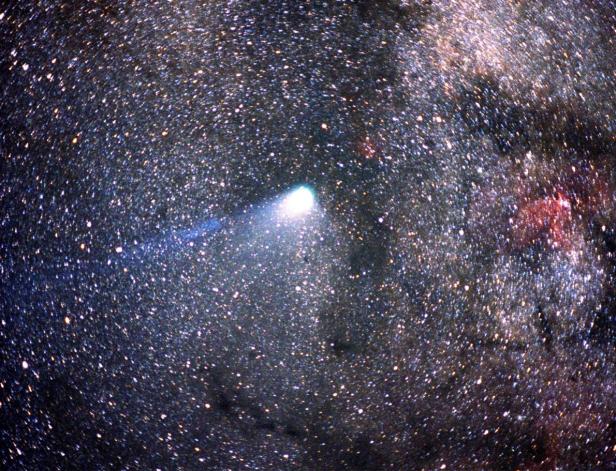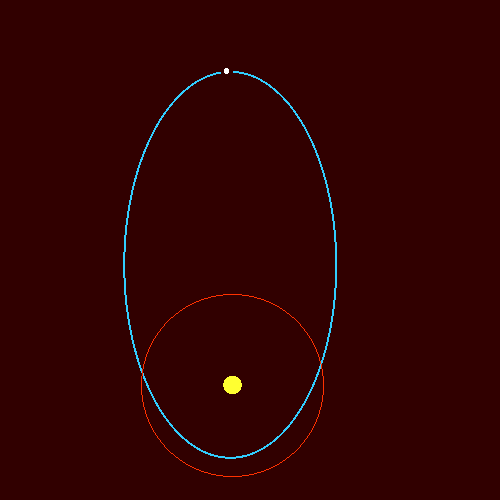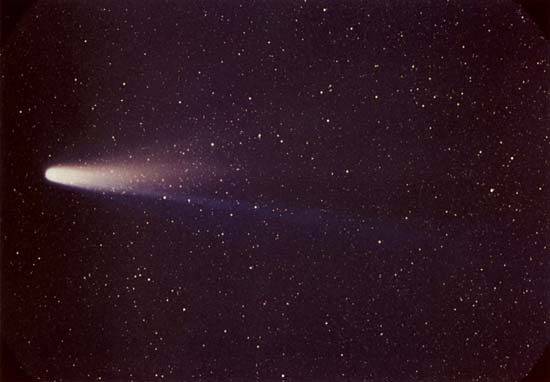“I just saw Halley’s comet
She waved
Said, “Why you always running in place?”
Even the man in the moon disappeared
Somewhere in the stratosphere”– Shinedown, “Second Chance”
It seems like I write a lot about songs that draw in astronomy and astrophysics. Just since starting this blog, I’ve written about Train’s “Drops of Jupiter,” Muse’s “Supermassive Black Hole,” and Jimmy Buffett’s “Desdemona’s Building a Rocket Ship” (which references quasars). There’s just something about these thrown in references that catches my attention.
So you can add this article onto the pile. I’m going to write about Halley’s comet, which is called out in Shinedown’s song “Second Chance.”
A comet is a celestial object made of ice and dust. At the center of the comet is the nucleus, composed of frozen water, carbon dioxide, ammonia, and methane. The nucleus is often less than 10 miles (16 kilometers) wide, but is surrounded by the coma, a large cloud of gas and dust created as the ice in the comet is warmed by the Sun and vaporizes. As the comet approaches the Sun, more ice vaporizes, causing the comet to “grow.” Taking into account the coma, a comet could expand out to about 1 million miles (1.6 million kilometers) wide. Comet tails form as gas and dust materials are pushed away from the main comet body by the Sun’s solar wind and radiation pressure.
Comets follow elongated elliptical orbits around the Sun. A comet’s elliptical orbit takes it close to the Sun before it’s flung out and away. Eventually, the comet returns to approach the Sun again, and the cycle repeats. The time it takes a comet to travel once around the Sun is referred to as its orbital period.
Some comets have orbital periods longer than 200 years. These are called long-period comets and are thought to originate from the Oort Cloud, a shell of icy objects that surrounds the Solar System. The Oort Cloud is thought to cover the area between 5,000 and 100,000 astronomical units (AU; 1 AU equals about 150 million kilometers or 93 million miles) away from the Sun. As a star passes by the Oort Cloud, the gravitational pull of the star can sling an icy object in towards the Sun, creating a comet.
Comets that have orbital periods of less than 200 years are known as short-period or periodic comets. These comets likely originate from the Kuiper Belt, a disc-shaped region beyond the orbit of Neptune. The Kuiper Belt stretches from 30 to 55 AUs away and is home to the dwarf planet Pluto. Gravitational interactions with the outer planets can put comets from the Kuiper Belt into their elliptical orbits.
Halley’s comet is a periodic comet that can be seen from Earth about every 75 years. The comet is named after English astronomer Edmond Halley, who published “A Synopsis of the Astronomy of Comets,” a catalog of comet orbitals, in 1705. Halley noted that comet observations made in 1531, 1607, and 1682 had very similar orbits. He determined that instead of three separate comet events, this was actually the same comet, and it would return again in 1758. Halley died in 1742, but he was credited with the discovery, and so the comet is named after him.
(Quick fun fact: While the singer in “Second Chance” pronounces Halley as rhyming with “daily,” many people pronounce Halley as rhyming with “valley.”)
Halley’s comet has popped up throughout history, well before Halley’s publication. The earliest observation of Halley’s comet may have actually been made by the ancient Greeks in 466 BC. In 239 BC, a group of Chinese astronomers observed a comet and recorded it in the Shih Chi and Wen Hsien Thung Khao chronicles. Babylon tablets give two more records at 164 and 87 BC. In 837, the comet was noted in records from Japan, China, the Middle East, and northern Europe. Halley’s comet reappeared again in 1066, right before William the Conqueror led the invasion of England. The comet even made it onto the Bayeaux Tapestry, which depicted the Norman Conquest. The comet’s appearance in 1222 may have inspired Genghis Khan to invade Europe. Italian artist Giotto may have been inspired by the comet in 1301 when he painted “The Adoration of the Magi.”

In more recent history, Mark Twain had an interesting connection with Halley’s comet. Twain is quoted as saying, “I came in with Halley’s comet in 1835. It is coming again next year, and I expect to go out with it. It will be the greatest disappointment of my life if I don’t go out with Halley’s comet. The Almighty said, no doubt: ‘Now here are these two unaccountable freaks; they came in together, they must go out together.’” Twain did indeed die in 1910, right after the comet’s return.
So what’s the connection to the song by Shinedown? Brent Smith, the lead singer from Shinedown, explained that the song is about deciding to chase after dreams. Halley’s comet is personified in the song, saying “Why you always running in place?” Perhaps this means that the comet has left and returned again, noticing that the singer hasn’t changed much at all. Historically, prior to understanding the science, comets were thought to be messages foretelling a major event or change. Perhaps the comet is marking the start of a new journey for the singer. As with any art, interpret it as you will.
Curious about how you can catch a glimpse of Halley’s comet? The last time the comet was seen was in 1986. Its projected return is 2061. You can track Halley’s comet at this link.
Keep calm and science on.




Such n meaningful n touching song, I like the lyrics n beat. 😊👌🤙🖐
LikeLike